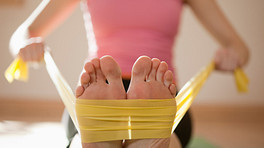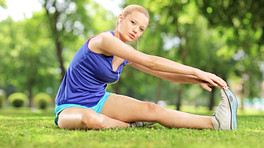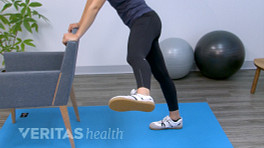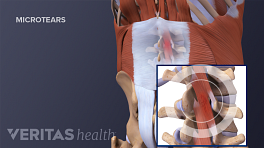High-impact exercises, such as running, have a jarring effect on the spine – potentially triggering or worsening sciatic nerve pain. 1 Girasole G, Hartman C, Moline K. The 7-Minute Back Pain Solution. Harlequin Enterprises Limited; 2012.
Sciatica occurs when a problem in the lumbar (low back) spine inflames or compresses the sciatic nerve roots, sending burning, electric shock-like pain down the thigh and leg. 2 Davis D, Maini K, Vasudevan A. Sciatica. [Updated 2022 May 6]. In: StatPearls [Internet]. Treasure Island (FL): StatPearls Publishing; 2023 Jan-. Available from: https://www.ncbi.nlm.nih.gov/books/NBK507908/ The health of your spine and the precautions you take while running play a role in the flaring of sciatica during a run.
Read more about Sciatica on Spine-health.com
In This Blog:
This blog explores how running impacts sciatica and ways to minimize back and leg pain during your run.
1. Running increases loads on the muscles and spine
Repetitive trauma from running can exacerbate muscle pain in the low back.
When you run, your feet constantly leave the ground and quickly make forceful contact with the ground again. This type of exercise is called an open-chain exercise and delivers repeated, high-impact forces to the lower back and discs. 1 Girasole G, Hartman C, Moline K. The 7-Minute Back Pain Solution. Harlequin Enterprises Limited; 2012.
With frequent and longer runs, repetitive trauma potentially worsens preexisting disc and muscle problems, leading to acute sciatic pain flare-ups. 1 Girasole G, Hartman C, Moline K. The 7-Minute Back Pain Solution. Harlequin Enterprises Limited; 2012.
Ways to decrease loads on the spine while running 1 Girasole G, Hartman C, Moline K. The 7-Minute Back Pain Solution. Harlequin Enterprises Limited; 2012. :
- Wear running shoes that fit well, are not worn down at the heel, and provide adequate arch support.
- Tighten your abdominal muscles slightly to activate your core when you run.
- Avoid routes with steep hills, potholes, or uneven terrains that increase the risk of injury or exacerbate your sciatica symptoms.
Read more about Sciatica Symptoms on Spine-health.com
When possible, choose soft terrains, like dirt trails or running tracks. They absorb more impact, reducing stress on the spine and buttocks while running.
2. A strong core distributes the loads evenly, reducing spinal stress
The core muscles balance and stabilize the spine.
Muscles in the abdomen and trunk, commonly called the core muscles, balance and stabilize the spine and distribute loads evenly between the spine and pelvis. When the core muscles are strong and engaged, they act as a natural shock absorber, preventing the spine from bearing the full brunt of the impact from running. 1 Girasole G, Hartman C, Moline K. The 7-Minute Back Pain Solution. Harlequin Enterprises Limited; 2012.
Fatigued and weak core muscles increase spinal and pelvic stress during running, worsening sciatica pain. 1 Girasole G, Hartman C, Moline K. The 7-Minute Back Pain Solution. Harlequin Enterprises Limited; 2012.
Similarly, when the piriformis muscle, located deep in the buttock, becomes fatigued, it spasms and exerts pressure on the adjacent sciatic nerve. This condition, called piriformis syndrome, mimics sciatica and is often observed in runners. 3 Roy BA. Piriformis syndrome. ACSM’S Health & Fitness Journal. 2014;18(4):3-4. doi:10.1249/FIT.0000000000000055
Ways to maintain muscle strength while running:
- Incorporate core strengthening exercises into your routine to strengthen your trunk, abdominal, lower back, and buttock muscles. Examples of core strengthening exercises include:
- Bridges
- Planks
- Bird-dog
- Lunges
- Leg raises
- Stay well-hydrated to maintain muscle function and prevent muscle weakness during runs.
Balancing exercises, including yoga, Pilates, and exercise (Swiss) ball workouts, also enhance core strength and improve stability, reducing the risk of falls and promoting overall fitness.
3. A balanced spinal posture reduces compressive forces on the discs and nerves
Maintaining a supported posture prevents sciatica flares while running.
While running, your spine and pelvis tend to tilt backward (extended position), causing repetitive compression on the spinal discs, nerves, and muscles each time your feet hit the ground. These compressive loads are further exacerbated if your muscles are fatigued. 1 Girasole G, Hartman C, Moline K. The 7-Minute Back Pain Solution. Harlequin Enterprises Limited; 2012.
Research indicates that most runners and joggers run in an extended position. 1 Girasole G, Hartman C, Moline K. The 7-Minute Back Pain Solution. Harlequin Enterprises Limited; 2012.
Ways to maintain a supported posture while running:
- Keep your back straight and avoid leaning forward or backward.
- Swing your arms forward and back, not side to side, to prevent twisting the spine.
- Focus on your breathing and take steady, deep breaths. Maintaining a consistent breathing rhythm prevents muscle tension.
When your spine is well-aligned, the compressive forces generated while running are evenly dispersed throughout your core muscles and don’t get concentrated in your spinal bones, discs, and nerves. 1 Girasole G, Hartman C, Moline K. The 7-Minute Back Pain Solution. Harlequin Enterprises Limited; 2012.
4. Warm-ups and cooldowns prevent muscle injury and soreness
Warming up before a run increases the heart rate, boosts circulation, and prepares the muscles for high-impact training. 4 Olsen O, Sjøhaug M, van Beekvelt M, Mork PJ. The effect of warm-up and cool-down exercise on delayed onset muscle soreness in the quadriceps muscle: a randomized controlled trial. J Hum Kinet. 2012;35:59-68. doi:10.2478/v10078-012-0079-4
Similarly, cooling down after a run decreases muscle soreness, increases flexibility in the lower back and limbs, and calms hyperactive nerves. 5 Heiss R, Lutter C, Freiwald J, et al. Advances in Delayed-Onset Muscle Soreness (DOMS) - Part II: Treatment and Prevention. Delayed Onset Muscle Soreness – Teil II: Therapie und Prävention. Sportverletz Sportschaden. 2019;33(1):21-29. doi:10.1055/a-0810-3516 , 6 Inami T, Shimizu T, Baba R, Nakagaki A. Acute changes in autonomic nerve activity during passive static stretching. AJSSM. 2014;2(4):166-170. doi:10.12691/ajssm-2-4-9
Ways to warm up and cool down:
- Incorporate 10 to 20 minutes of warming-up exercises before you start running.
- Warm-up exercises include hamstring stretches, jumping jacks, hip rotation, and arm circles.
- If you don’t have time for dedicated warm-up exercises, start your run at a slower pace. For example, start with a brisk walk, slowly transitioning into a jog, and then run.
Applying heat to your lower back/buttock for 10 to 20 minutes loosens the muscles around your sciatic nerve and encourages healing in the area.
- Like warm-ups, gradually transitioning to brisk walking and slow walks after your run allows the body to cool down.
5
Heiss R, Lutter C, Freiwald J, et al. Advances in Delayed-Onset Muscle Soreness (DOMS) - Part II: Treatment and Prevention. Delayed Onset Muscle Soreness – Teil II: Therapie und Prävention. Sportverletz Sportschaden. 2019;33(1):21-29. doi:10.1055/a-0810-3516
Alternative ways to cool down are
5
Heiss R, Lutter C, Freiwald J, et al. Advances in Delayed-Onset Muscle Soreness (DOMS) - Part II: Treatment and Prevention. Delayed Onset Muscle Soreness – Teil II: Therapie und Prävention. Sportverletz Sportschaden. 2019;33(1):21-29. doi:10.1055/a-0810-3516
:
- Stretching exercises, such as hamstring stretches
- Foam rolling
- Nerve glide or sciatic nerve flossing exercise
See Exercises to Lessen Back Pain While Running
Running with sciatica requires patience and preparation. The key is to listen to your body, take it slow, and focus on the long-term resolution of the underlying cause of sciatica.
If running causes severe pain, exacerbates existing symptoms, or causes new concerning symptoms, it is advisable to stop running and seek advice from a trained healthcare professional.
Read more about Sciatica Treatment on Spine-health.com
- 1 Girasole G, Hartman C, Moline K. The 7-Minute Back Pain Solution. Harlequin Enterprises Limited; 2012.
- 2 Davis D, Maini K, Vasudevan A. Sciatica. [Updated 2022 May 6]. In: StatPearls [Internet]. Treasure Island (FL): StatPearls Publishing; 2023 Jan-. Available from: https://www.ncbi.nlm.nih.gov/books/NBK507908/
- 3 Roy BA. Piriformis syndrome. ACSM’S Health & Fitness Journal. 2014;18(4):3-4. doi:10.1249/FIT.0000000000000055
- 4 Olsen O, Sjøhaug M, van Beekvelt M, Mork PJ. The effect of warm-up and cool-down exercise on delayed onset muscle soreness in the quadriceps muscle: a randomized controlled trial. J Hum Kinet. 2012;35:59-68. doi:10.2478/v10078-012-0079-4
- 5 Heiss R, Lutter C, Freiwald J, et al. Advances in Delayed-Onset Muscle Soreness (DOMS) - Part II: Treatment and Prevention. Delayed Onset Muscle Soreness – Teil II: Therapie und Prävention. Sportverletz Sportschaden. 2019;33(1):21-29. doi:10.1055/a-0810-3516
- 6 Inami T, Shimizu T, Baba R, Nakagaki A. Acute changes in autonomic nerve activity during passive static stretching. AJSSM. 2014;2(4):166-170. doi:10.12691/ajssm-2-4-9










